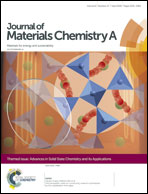Nano-scale hydroxyapatite compositions for the utilization of CO2 recovered using post-combustion carbon capture
Abstract
The synthesis and analysis of a sodium-carbonate co-substituted hydroxyapatite (Ca10−xNax(PO4)6−x(CO3)x(OH)2) with potential applications in carbon capture technologies is described. A co-substituted hydroxyapatite, using NaCl as the source of sodium, containing approximately 14 wt% carbonate was successfully prepared by an aqueous precipitation reaction followed by a thermal treatment under a stream of CO2 gas at 500 °C. In order to reach this level of carbonation, CO2 gas was constantly supplied to the reactant mixture during precipitation. Another hydroxyapatite prepared with sodium carbonate, Na2CO3, in non-carbonated water but following the same methodology, incorporated a higher level (approximately 17 wt%) of carbonate. This increase was likely a result of additional carbonate provided by the sodium carbonate starting material. The underlying aim of this work was to examine the possibility of using hydroxyapatites to incorporate carbon dioxide from gas recovered from post-combustion carbon capture (PC-CC) techniques. As the chemical composition of these materials resembles bone mineral, it may be possible to use the final product in agriculture as a slow-release fertilizer and thus make use of the products.

- This article is part of the themed collection: Advances in Solid State Chemistry and its Applications


 Please wait while we load your content...
Please wait while we load your content...